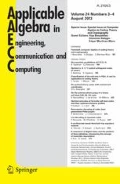Abstract
This work develops a novel framework which can automatically detect, parameterize and interpolate periodic motion patterns obtained from a motion capture sequence. Using our framework, periodic motions such as walking and running gaits or any motion sequence with periodic structure such as cleaning, dancing etc. can be detected automatically and without manual marking of the period start and end points. Our approach constructs an intrinsic parameterization of the motion and is computationally fast. Using this parameterization, we are able generate prototypical periodic motions. Additionally, we are able to interpolate between various motions, yielding a rich class of ‘mixed’ periodic actions. Our approach is based on ideas from applied algebraic topology. In particular, we apply a novel persistent cohomology based method for the first time in a graphics application which enables us to recover circular coordinates of motions. We also develop a suitable notion of homotopy which can be used to interpolate between periodic motion patterns. Our framework is directly applicable to the construction of walk cycles for animating character motions with motion graphs or state machine driven animation engines and processed our examples at an average speed of 11.78 frames per second
Graphical abstract












Similar content being viewed by others
Notes
Our contributions are also outlined in a video summary, accessible at http://www.youtube.com/watch?v=NGQ-M2gdibQ.
Recall that our human motion input data lies in a 62 dimensional configuration space \(\mathcal {C}\).
References
CMU Graphics Lab: CMU graphics lab motion capture database. http://mocap.cs.cmu.edu/ (2012). Accessed Nov 2012
Muico, U., Lee, Y., Popović, J., Popović, Z.: Contact-aware nonlinear control of dynamic characters. In: SIGGRAPH, pp. 81:1–81:9 (2009)
Yin, K., Coros, S., Beaudoin, P., van de Panne, M.: Continuation methods for adapting simulated skills. In: SIGGRAPH, pp. 81:1–81:7 (2008)
Argall, B.D., Chernova, S., Veloso, M., Browning, B.: A survey of robot learning from demonstration. Robot. Auton. Syst. 57, 469–483 (2009)
Unity Technologies (2013) Unity 4. Commercial Software
Witkin, A., Kass, M.: Spacetime constraints. In: SIGGRAPH, pp. 159–168 (1988)
Rose, C., Guenter, B., Bodenheimer, B., Cohen, M.F.: Efficient generation of motion transitions using spacetime constraints. In: SIGGRAPH, pp. 147–154 (1996)
Fang, A.C., Pollard, N.S.: Efficient synthesis of physically valid human motion. ACM Trans. Graph. 22, 417–426 (2003)
Liu, C.K., Hertzmann, A., Popović, Z.: Composition of complex optimal multi-character motions. In: SCA ’06, pp. 215–222 (2006)
Kovar, L., Gleicher, M., Pighin, F.: Motion graphs. In: SIGGRAPH, pp. 473–482 (2002)
Arikan, O., Forsyth, D.A.: Interactive motion generation from examples. ACM Trans. Graph. 21, 483–490 (2002)
Kovar, L., Gleicher, M.: Automated extraction and parameterization of motions in large data sets. In: SIGGRAPH, pp. 559–568 (2004)
Safonova, A., Hodgins, J.K.: Construction and optimal search of interpolated motion graphs. ACM Trans. Graph. 26 (2007)
Guo, S., Robergé, J.: A high-level control mechanism for human locomotion based on parametric frame space interpolation. In: Proceedings of the Eurographics Workshop on Computer Animation and Simulation ’96, pp. 95–107 (1996)
Wiley, D.J., Hahn, J.K.: Interpolation synthesis for articulated figure motion. In: VRAIS ’97 (1997)
Beaudoin, P., Coros, S., van de Panne, M., Poulin, P.: Motion-motif graphs. In: SCA ’08, pp. 117–126 (2008)
Gleicher, M., Shin, H.J., Kovar, L., Jepsen, A.: Snap-together motion: assembling run-time animations. In: SIGGRAPH, pp. 52:1–52:9 (2008)
Pullen, K., Bregler, C.: Animating by multi-level sampling. In: Computer Animation, pp. 36–42 (2000)
Mukai, T.: Motion rings for interactive gait synthesis. In: I3D ’11, pp. 125–132 (2011)
Peternel, M., Leonardis, A.: Visual learning and recognition of a probabilistic spatio-temporal model of cyclic human locomotion. In: ICPR, vol. 4, pp. 146–149 (2004)
Lamar-Len, J., Garca-Reyes, E., Gonzalez-Diaz, R.: Human gait identification using persistent homology. Prog. Pattern Recognit. Image Anal. Comput. Vision Appl. 7441, 244–251 (2012)
Vasudevan, R., Ames, A., Bajcsy, R.: Persistent homology for automatic determination of human-data based cost of bipedal walking. Nonlinear Anal. Hybrid Syst. 7(1), 101–115 (2013). (IFAC World Congress 2011)
Takens, F.: Detecting strange attractors in turbulence. Dyn. Syst. Turbul. Warwick 1980, 366–381 (1981)
Hatcher, A.: Algebraic Topology. Cambridge University Press, Cambridge (2002)
Edelsbrunner, H., Harer, J.: Computational Topology: An Introduction. AMS Press, New York (2009)
Morozov, D., de Silva, V., Vejdemo-Johansson, M.: Persistent cohomology and circular coordinates. Discrete Comput. Geom. 45(4), 737–759 (2011)
Morozov, D.: Dionysus. http://www.mrzv.org/software/dionysus/ (2011). Accessed Nov 2012
Jones, E., Oliphant, T., Peterson, P., et al.: SciPy: open source scientific tools for Python. http://www.scipy.org/ (2001)
Pedregosa, F., Varoquaux, G., Gramfort, A., Michel, V., Thirion, B., Grisel, O., Blondel, M., Prettenhofer, P., Weiss, R., Dubourg, V., Vanderplas, J., Passos, A., Cournapeau, D., Brucher, M., Perrot, M., Duchesnay, E.: Scikit-learn: machine learning in python. J. Mach. Learn. Res. 12, 2825–2830 (2011)
de Silva, V., Carlsson, G.: Topological estimation using witness complexes. In: Symposium on Point-Based Graphics (2004)
Edelsbrunner, H., Kirkpatrick, D., Seidel, R.: On the shape of a set of points in the plane. IEEE Trans. Inf. Theory 29, 551–559 (1983)
Edelsbrunner, H., Mücke, E.P.: Three-dimensional alpha shapes. In: Proceedings of the VVS, pp. 75–82 (1992)
Barbic, J., Zhao, Y.: mocapPlayer. http://graphics.cs.cmu.edu/software/mocapPlayer.zip (2012). Accessed Nov 2012
Autodesk (2013) Maya. Commercial software
Fornberg, B.: Generation of finite difference formulas on arbitrarily spaced grids. Math. Comput. 51(184), 699–706 (1988)
Craig, J.: Introduction to Robotics: Mechanics and Control. Prentice Hall, Englewood Cliffs (2004)
Lee, J., Chai, J., Reitsma, P.S., Hodgins, J.K., Pollard, N.S.: Interactive control of avatars animated with human motion data. ACM Trans. Graph. (TOG) 21, 491–500 (2002)
Author information
Authors and Affiliations
Corresponding author
Rights and permissions
About this article
Cite this article
Vejdemo-Johansson, M., Pokorny, F.T., Skraba, P. et al. Cohomological learning of periodic motion. AAECC 26, 5–26 (2015). https://doi.org/10.1007/s00200-015-0251-x
Received:
Revised:
Accepted:
Published:
Issue Date:
DOI: https://doi.org/10.1007/s00200-015-0251-x




